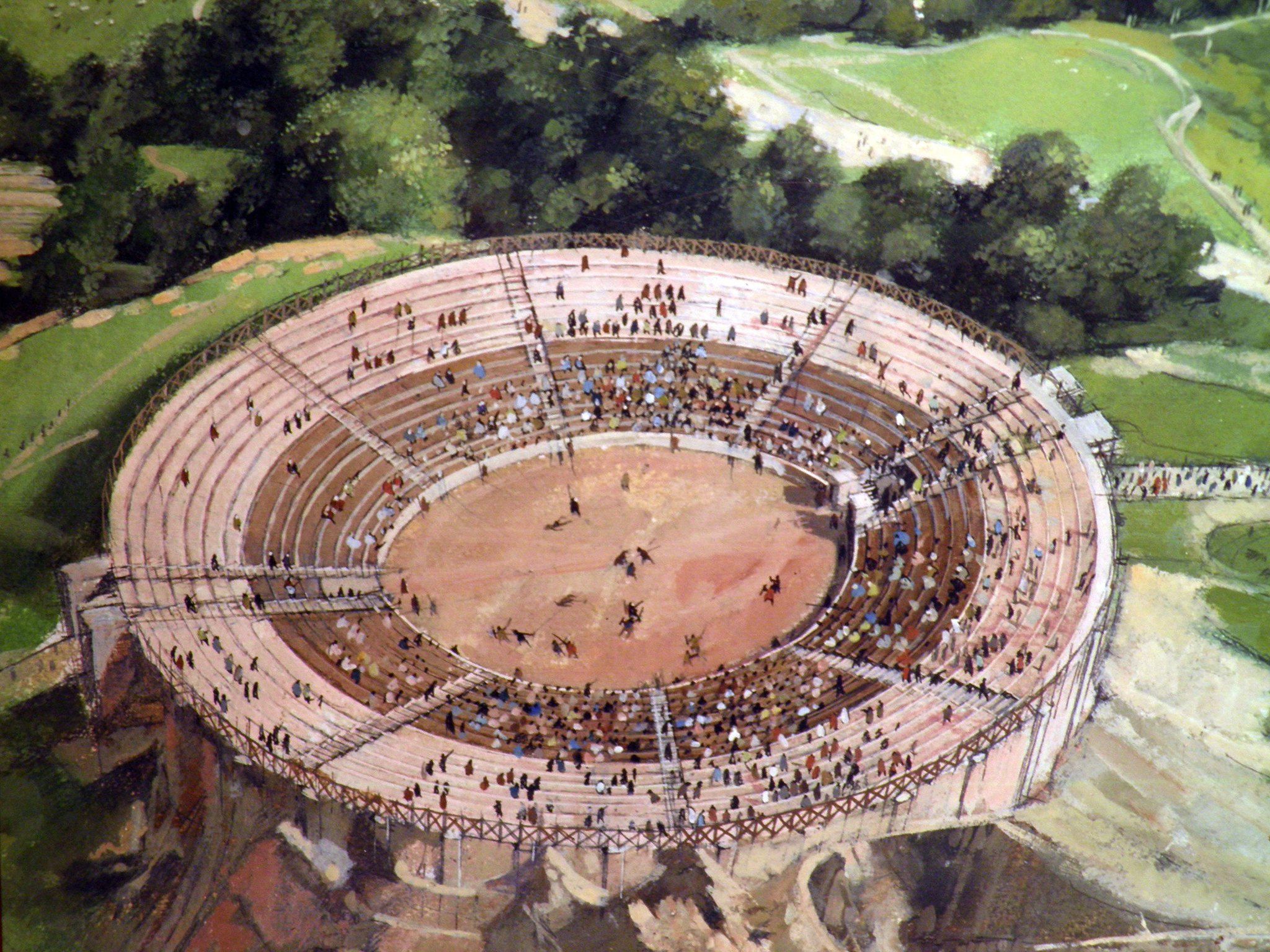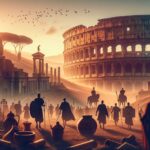Step back in time at Cirencester’s Roman Amphitheatre, one of Britain’s largest and best-preserved, revealing a captivating glimpse into Roman life in Corinium. More than just ruins, discover the rich history, architectural marvels, and surprising modern uses of this iconic site. From gladiatorial contests to community events, explore the evolving story of Cirencester Amphitheatre, a testament to its enduring legacy. Plan your perfect visit: from accessibility details to nearby attractions, this guide unlocks the secrets of Cirencester’s Amphitheatre and the surrounding area.
A Colossus of Corinium: Roman Entertainment at its Peak
Imagine bustling Corinium (modern-day Cirencester) around 2,000 years ago. The Cirencester Amphitheatre, built in the early 2nd century AD, wasn’t just a building; it was the place to be. Picture the roar of the crowd, the clash of steel, the gasp of the audience! Its sheer size—one of the largest in Britain, capable of holding around 8,000 people—highlights Corinium’s importance and its citizens’ love of spectacle. While gladiatorial combat was a major draw, the amphitheatre likely also hosted public executions and other spectacular events––a Roman equivalent of a multi-purpose stadium and execution ground.
Architectural Wonders: Then and Now
The Cirencester Amphitheatre wasn’t just about the entertainment; it was a feat of Roman engineering. The arena itself—approximately 150 feet by 135 feet—was the stage for life-or-death drama. Around it rose massive tiered seats, some reaching an impressive 25 feet high, perfectly designed for thousands of spectators. The sheer scale of earthworks required to create these seating banks is still visible today, a lasting testament to Roman skill and ambition. Archaeological digs continue to unearth fascinating objects, each discovery adding another layer to our understanding. Many secrets, however, likely remain buried, awaiting future discoveries and ongoing research.
Visiting the Cirencester Amphitheatre: Your Roman Adventure
Ready for your own Roman adventure? The Cirencester Amphitheatre awaits!
- Location: Cotswold Avenue, Cirencester, GL7 1XW. Easily accessible and well signposted.
- Accessibility: Check the English Heritage website for details on accessibility features.
- Opening Times & Cost: Generally free entry but always check the English Heritage website for the most up-to-date information.
- Nearby Attractions: Combine your visit with a trip to the Corinium Museum, packed with Roman artifacts, and explore the charming town of Cirencester itself.
Beyond the Stones: The Amphitheatre Today
The Cirencester Amphitheatre isn’t merely a relic; it’s a vibrant part of the community. Special events occasionally breathe new life into this ancient space, while educational programs bring history to life for students. Ongoing conservation efforts are vital to preserving this remarkable site for future generations, a testament to our commitment to shared heritage.
The Cirencester Amphitheatre: A British Giant
Compared to other Roman amphitheatres in Britain, Cirencester’s stands out for its size and remarkable preservation. It’s not just ruins; it’s a unique window into Roman life, a story of entertainment, power, and the lasting legacy of empire.
Further Exploration: Unraveling the Mysteries
Although much is known, many unanswered questions remain about the Cirencester Amphitheatre. Ongoing archaeological excavations may reveal further details about its construction, use, and decline. Some experts believe its size reflects Corinium’s economic prosperity and social importance during the Roman era, while other interpretations exist. Ongoing research is crucial in refining our understanding of this significant historical landmark. The mysteries of the past continually inspire new research and reinterpretations—keep checking back!
What Happened in a Roman Amphitheatre?
What really went down in a Roman amphitheatre? It wasn’t just gladiators, though they certainly played a pivotal role. Think of it as ancient Rome’s ultimate entertainment complex—a place where the entire city gathered for spectacular, often brutal, and always memorable events.
More Than Swords and Sandals: A Diverse Entertainment Program
Roman amphitheaters were incredibly diverse. While gladiatorial combat was a huge draw, the programming was varied. Imagine a modern stadium hosting everything from UFC fights to monster truck rallies to elaborate firework displays – that’s just a glimpse of the range of events.
Gladiatorial Games: Skill, Spectacle, and Social Commentary
Gladiatorial combat was highly skilled performance, not just a bloodbath. Each gladiator specialized in a fighting style, using different weapons and armor. It combined athleticism, strategy, and theatrical flair – something like modern mixed martial arts with carefully choreographed action. These contests also reflected Roman social structures and power dynamics, with victories and defeats impacting a gladiator’s status and the prestige of their wealthy patrons.
Beyond the Arena: Animal Hunts and Naval Battles
Venationes, or animal hunts, were equally popular, pitting animals against each other or condemned criminals—a terrifying spectacle of Roman power. Naumachiae, mock naval battles staged in specially constructed arenas, required immense planning and resources, demonstrating Rome’s military strength.
The Darker Side: Executions and Political Statements
Amphitheaters also hosted public executions of criminals and political enemies—a stark display of Roman state power. These, alongside theatrical performances and propaganda rallies, showcase the multifaceted role of these venues.
Architectural Marvels: Design and Engineering Brilliance
Amphitheaters were architectural masterpieces. Their design ensured smooth crowd flow and excellent acoustics. The ingenious vomitoria—literally, “vomiting places”—served as strategically placed entrances and exits. Carefully planned seating reflected Roman social hierarchy. The sheer scale demonstrates sophisticated engineering, logistics, and crowd management.
A Lasting Legacy: Shaping Culture and Society
Roman amphitheaters weren’t just entertainment venues but powerful tools for social control and political messaging. Their influence extended far beyond their physical existence, shaping Roman culture and leaving an undeniable mark on Western civilization.
From Glory to Ruins: A Continuing Story
The fall of Rome ended the amphitheatres’ golden age but not their story. Many were repurposed or used as quarries, yet their ruins remain silent witnesses to a fascinating past. Preserved and studied today, they draw visitors worldwide, evoking the spirit of a vibrant past and the enduring human fascination with grand spectacles. Current archaeological research shows our understanding of their history will continue to evolve.
What Happened at an Amphitheatre? A Closer Look at Cirencester
Let’s focus on the Cirencester Amphitheatre. In 120 AD, it was a bustling hub of Roman life in Corinium. This massive oval structure, capable of holding around 8,000 people, hosted a range of events.
Gladiatorial contests were a major attraction, but the amphitheatre likely also hosted thrilling animal hunts (venationes) and even mock naval battles (naumachiae), requiring immense logistical planning to flood the arena. The amphitheatre’s design was a marvel of Roman engineering. Strategically located entrances (vomitoria) ensured efficient crowd flow, while the acoustics were cleverly engineered for optimal sound. It was more than just entertainment; it was sophisticated engineering and planning with the tools they had back then.
Beyond the spectacles, the Cirencester Amphitheatre tells a larger story about daily life in Corinium, reflecting Roman power and authority and serving as a powerful symbol of their empire in Britain. Today, the ruins are a testament to Roman ingenuity and the enduring human desire for collective experiences.
Here’s a summary of likely events:
| Event Type | Description | Significance |
|---|---|---|
| Gladiatorial Combat | Battles between trained fighters. | Display of skill, social hierarchy, and power of patrons. |
| Venationes (Animal Hunts) | Fights between wild animals, sometimes involving gladiators. | Spectacle, demonstration of Roman power and control over exotic resources. |
| Naumachiae (Mock Naval Battles) | Simulated sea battles, requiring flooding of the arena. | Logistical marvel showcasing Roman engineering and dominance over sea power. |
| Public Executions | Punishment of criminals and political enemies. | Public demonstration of Roman justice and authority. |
| Theatrical Performances | Plays and other dramatic presentations. | Entertainment and reflection of Roman values. |
Ongoing research continues to refine our understanding of Roman amphitheaters, underscoring the dynamic nature of historical study.
The History of Roman Cirencester (Corinium Dobunnorum)
Let’s explore the history of Cirencester (Corinium Dobunnorum), a pivotal Roman city in Britain.
Corinium Dobunnorum: A Roman Hub
Founded after the 43 AD Roman conquest, Corinium rapidly grew into a significant administrative center, likely with a population exceeding 10,000. Its strategic location and impressive infrastructure, including well-maintained roads and substantial buildings, point to a sophisticated urban environment. The town’s well-planned layout and substantial public buildings suggest a highly organized and prosperous settlement.
The Amphitheatre: A Center of Roman Life
The Cirencester Amphitheatre, built around the early 2nd century AD, held approximately 8,000 spectators. It hosted gladiatorial combats, animal hunts, theatrical performances, and even public executions, offering a diverse range of entertainments and symbolic displays of Roman power.
Unearthing the Past: Archaeological Insights
Archaeological discoveries in Cirencester have unveiled temples, public baths, and numerous everyday artifacts, providing valuable insights into the lives of its Roman inhabitants. These finds paint a picture of daily life, social structures, and religious practices within Corinium.
Decline and Enduring Legacy
Like many Roman settlements, Corinium experienced a decline with the fall of Roman rule in Britain (late 4th-5th centuries AD). Its legacy, however, remains profound. The surviving ruins stand as powerful symbols of Roman engineering and Cirencester’s importance in Roman Britain.
Further Research and Ongoing Discoveries
Our understanding of Roman Cirencester continues to evolve as ongoing research and new discoveries reshape our knowledge. There is still much to be explored and understood. Some experts propose different interpretations of the city’s layout and social dynamics, highlighting the dynamic nature of archaeological study. The study of Roman Cirencester remains a rich and rewarding field, continually adding to and revising our knowledge.
- SYBAU See You Baby Meaning: Gen Z Slang Evolves - July 1, 2025
- Unlock Your Inner Youth: Lifestyle Secrets for a Vibrant Life - July 1, 2025
- Decode SYBAU Meaning: Gen Z Slang Explained - July 1, 2025






